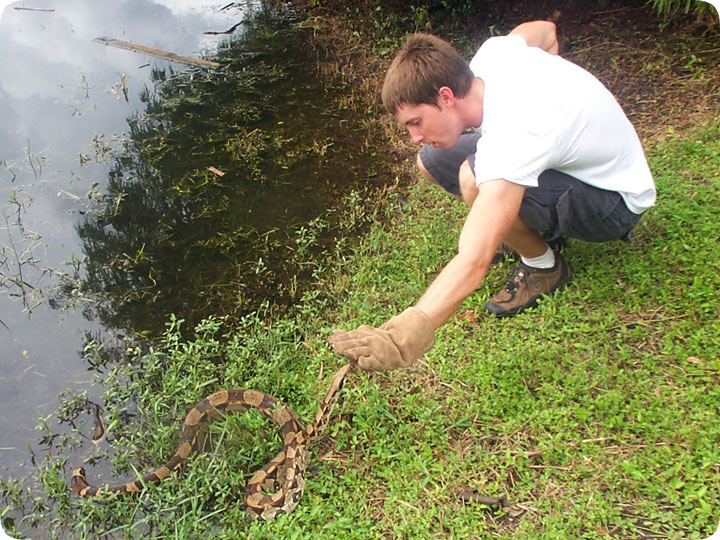-
info@aaanimalcontrol.com
Call us for help in your town
Humane Wildlife Education
Boa Constrictor In Florida

11.08.2003 - Florida is home to many non-native species of plants and animals. People seem to become particularly excited about the presence of non-native snakes. It's true that Florida is host to several species of foreign snake. The subtropical climate
allows for survival of certain species that usually only live in jungles in areas such as central and South America, such as snakes.
One such snake is the Boa Constrictor.
This is a very well-known snake, and is a member of the Boinae family. It's not nearly as large as the Reticulated Python or the Anaconda, or even the Burmese python, all of
which have been found in the state of FL at varying times, but it
can grow to a fairly large size, up to 12 feet, even a little more at times. Above is a photo of a Boa Constrictor that I caught here in Orlando Florida. It was about 6 feet
long. Here I am playing with it near a lake in Orlando.
The big question is
about the origin of this snake. Was it a released or escaped pet, or was it born in the wild here in Orlando Florida? I'm going to guess that this particular snake was a pet. While it's true that some species of python have in fact established breeding and sustained
populations in southern Florida, I just don't think that Orlando is quite warm enough for these snakes. In addition, I've only come across them on rare occasion. I think that if they were breeding here, I'd see them more often, and I'd see more small boas than I do.
I think larger ones such as this are merely pets whose owners released them, because they got tired of keeping a large snake around. However, I'm not sure that I'm correct, and it's possible, even if this Florida Boa Constrictor pictured above is a former pet, that there
are boas in the Orlando area. As for the rest of Florida, I do believe that there are self-sustaining populations of Boa Constrictor in southern Florida, along with the established Burmese Pythons in that part of the state.
Do it yourself: Visit my How To Get Rid of Snakes page for tips and advice.
Get professional help: Visit my Nationwide Pro Directory of wildlife removal experts.
For more wildlife stories, click my Wildlife Blog
or click my below banner to hire a local trapper.
Snakes are creepy creatures, the sight of them freak people out and make adrenaline run through their veins. Despite how weird they are, not every snake is poisonous of which the Boa Constrictor happens to be one of them. Being one of the largest snake species in the world with an average length and weight of 12 feet and 27kg respectively, Boa Constrictors are major reptiles in the animal world.
Right here, we will be sharing all you need to know about the Boa Constrictor, it's habitat, behavioral patterns, diet, and reproduction habits.
Habitat
Boa Constrictors have a special adaptive system that allows them to survive in different regions around the globe. But in particular, these snakes prefer to live in a humid environment with lots of colorful trees and at the banks of streams and rivers. Boa Constrictors in Florida are common along the coast. In this part of the world, they are classified as released pets, which means you can come across them easily around your home.
Diet
Unlike other snakes, Boa Constrictors are non-venomous. They mostly feed on birds, rodents, and other medium-sized mammals by constricting them. But as they grow bigger, their appetite for larger mammals increases. They are even known to have the ability to prey on animals as large as ocelots.
Boa Constrictors are otherwise called sneaky predators. These snakes will patiently wait for as long as possible just to catch their prey off-guard and strike it with their teeth. When it finally gets an opportunity to do so, it will constrict the animal until it dies and then gently swallow it. Boa Constrictors take about 5 days to fully consume and digest their prey.
Reproduction
Boa Constrictors are one of the few snakes that give birth to their young alive. They start breeding from late spring to early summer. A male Boa Constrictor mates with different females and doesn't take part in nurturing their offspring. In rare cases, female Boa Constrictors are known to have reproduced asexually in the absence of a mate.
The average length of a baby Boa Constrictor at birth is between five to six feet. After a few weeks, the offspring will begin to hunt for prey and start its own life with no support from its mother.
Due to our instinct as humans and fear of snakes, people are always out to look for the best way to kill Boa Constrictors. But the fact is, these snakes are no danger to humans. So if you encounter a Boa Constrictor, the best thing you can do is to leave it alone and let it go.
If you don't feel too comfortable with having it around, you can get a trap to help catch it or hire a professional wildlife removal service to help remove it from your home. They will do a perfect job for you and you won't have to worry about the snake sneaking up on you anymore.




















